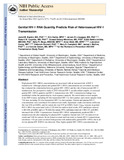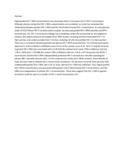| dc.description.abstract | High plasma HIV-1 RNA concentrations are associated with an increased risk of HIV-1 transmission. Although plasma and genital HIV-1 RNA concentrations are correlated, no study has evaluated the relationship between genital HIV-1 RNA and the risk of heterosexual HIV-1 transmission. In a prospective study of 2521 African HIV-1 serodiscordant couples, we assessed genital HIV-1 RNA quantity and HIV-1 transmission risk. HIV-1 transmission linkage was established within the partnership by viral sequence analysis. We tested endocervical samples from 1805 women, including 46 who transmitted HIV-1 to their partner, and semen samples from 716 men, including 32 who transmitted HIV-1 to their partner. There was a correlation between genital and plasma HIV-1 RNA concentrations: For endocervical swabs, Spearman's rank correlation coefficient ρ was 0.56, and for semen, ρ was 0.55. Each 1.0 log(10) increase in genital HIV-1 RNA was associated with a 2.20-fold (for endocervical swabs: 95% confidence interval, 1.60 to 3.04) and a 1.79-fold (for semen: 95% confidence interval, 1.30 to 2.47) increased risk of HIV-1 transmission. Genital HIV-1 RNA independently predicted HIV-1 transmission risk after adjusting for plasma HIV-1 quantity (hazard ratio, 1.67 for endocervical swabs and 1.68 for semen). Seven female-to-male and four male-to-female HIV-1 transmissions (incidence <1% per year) occurred from persons with undetectable genital HIV-1 RNA, but in all 11 cases, plasma HIV-1 RNA was detected. Thus, higher genital HIV-1 RNA concentrations are associated with greater risk of heterosexual HIV-1 transmission, and this effect was independent of plasma HIV-1 concentrations. These data suggest that HIV-1 RNA in genital secretions could be used as a marker of HIV-1 sexual transmission risk. | en |


